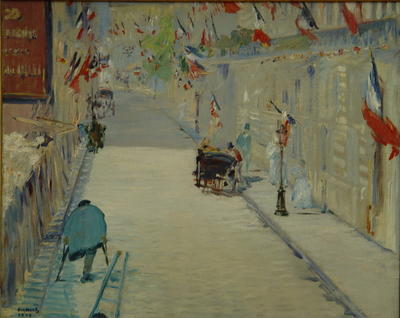On this Independence Day, I think of the Americans who were forced from their homes and businesses on the west coast to internment camps spread across the US interior by President Roosevelt’s signing of Executive Order 9066 on February 19, 1942.

During the 1940's, the town of Topaz was one of the largest cities in Utah. Like most towns, there were houses, gardens and elementary schools. Unlike most towns, there were barbed-wire fences and guard towers marking the city line.

George Matsusaburo Hibi
Guard Tower - Topaz Camp
22" x 18" oil on canvas 1944
On June 11th 2005, in the Utah desert , a group of ageing Japanese Americans boarded buses for a dusty trip back to the Topaz Internment Camp to remember the 60th anniversary of their release from Franklin Delano Roosevelt’s Executive Order 9066.

Hisako Hibi
"Western Sky"
oil on canvas July 1, 1945
Topaz internment camp opened on September 11, 1942. Situated 140 miles south of Salt Lake City, the high desert winds stirred up frequent dust storms which cut through the wood and tarpaper shacks built to house the internees.
The internees at Topaz were primarily from California and almost completely urban in origin.
One of the internees was the painter
Hisako Hibi(1907-1991). At Topaz, Hisako Hibi and her husband, George Matsusaburo Hibi, taught art in the camp schools.
The work of
Hisako Hibi was featured in a recent exhibition in the De Saisset Museum at Santa Clara University in California.
The exhibition also marked the publication of Hisako Hibi's:
"Peaceful Painter: Memoirs of an Issei Woman Artist"

Hisako Hibi
"Homage to Mary Cassatt"
24" x 20" oil on canvas 1943
Topaz was closed on October 31, 1945. It was not until the passage of the Civil Rights Act of 1988 that the US Government officially apologized for the unjust incarceration. Upon release, the Hibi family moved to Hells Kitchen in Manhattan. Hibi worked as a dressmaker to support her family and continued to paint.
Her husband,George Hibi, died within two years but Hisako stayed on, raised her children, and studied at the Museum of Modern Art. Hisako Hibi continued painting for the next forty years and, after she returned to San Francisco in 1954, exhibited her work in numerous group and solo exhibitions.

George Matsusaburo Hibi
"Men Painting, Sunset, Topaz"
20" x 24" oil on canvas 1944
Hisako Hibi's posthumous memoir has generated rich reviews:
"This is a beautiful and inspiring book. The words and paintings of Hisako Hibi add an important chapter to the still-unfolding story of what Japanese Americans experienced during the World War II internment. They also tell the story of a remarkable life, one that illustrates the indomitable spirit of the Issei, the pioneering first generation."
—James D. Houston and Jeanne Wakatsuki Houston, authors of Farewell to Manzanar
"With her luminous art and the grace and poignancy of her words, Hisako Hibi tells her remarkable journey as an immigrant woman, wife, mother, and artist. Her story of survival and accomplishment is made all the more extraordinary by the gentle wisdom of her voice."
—Kimi Kodani Hill, author of Topaz Moon
"Through her words and art, the remarkable Hisako Hibi conveys the harsh challenge of life within the Tanforan Assembly Center and the Topaz internment camp, as well as the generous, resilient spirit that enabled her to endure and prevail. Her compassion and creative drive infuse this engaging memoir."
—Valerie Matsumoto, Professor of History/Asian American Studies, UCLA
As an American, I celebrate the achievements of our country. And as an American, I remember the mistakes and injustices of our past. Hisako Hibi and more than 120,000 Americans of Japanese descent were unjustly imprisoned behind barbed wire. In the midst of another war, I remember where the fear of an unknown enemy can lead our country. I stand with the ageing veterans of Topaz and declare,"Never Again."
Hisako Hibi Archive at UCLA






